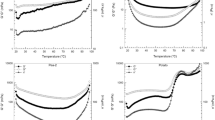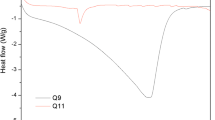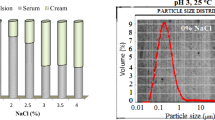Abstract
This study was systematically investigated the bulk and interfacial rheological properties of the poppy seed proteins as new source of plant proteins for healthier diets. Results revealed that low molecular weight of proteins (> 15 kDa) might contribute to the emulsion stability. The droplet size increased inversely with protein band density in the 10–15 kDa range. The pH value of the most stable emulsion was pH 3.0. An increasing trend of emulsion activity was observed for decreasing pH values which perhaps could be attributed to an opening of protein conformational structures. The optical microscopy results showed that the decrease in pH resulted in a better storage stability as promoting the formation of a more uniform distribution and smaller oil droplets. We conclude that present study puts forth a major contribution to plant protein research by demonstrating its ability to make stable emulsion as a function of pH at the O/W interface.







Similar content being viewed by others
References
Lam RSH, Nickerson MT (2013) Food proteins: a review on their emulsifying properties using a structure-function approach. Food Chem 141:975–984. https://doi.org/10.1016/j.foodchem.2013.04.038
McClements DJ (2004) Protein-stabilized emulsions. Curr Opin Colloid Interface Sci 9:305–313
Damodaran S (2005) Protein stabilization of emulsions and foams. J Food Sci 70:54–66. https://doi.org/10.1111/j.1365-2621.2005.tb07150.x
Tamm F, Herbst S, Brodkorb A, Drusch S (2016) Functional properties of pea protein hydrolysates in emulsions and spray-dried microcapsules. Food Hydrocoll 58:204–214. https://doi.org/10.1016/j.foodhyd.2016.02.032
Gumus CE, Decker EA, McClements DJ (2017) Formation and stability of ω-3 oil emulsion-based delivery systems using plant proteins as emulsifiers: lentil, pea, and faba bean proteins. Food Biophys 12:186–197. https://doi.org/10.1007/s11483-017-9475-6
Qamar S, Bhandari B, Prakash S (2019) Effect of different homogenisation methods and UHT processing on the stability of pea protein emulsion. Food Res Int 116:1374–1385. https://doi.org/10.1016/j.foodres.2018.10.028
Srinivas H, Rao MN (1986) Functional properties of poppy seed meal. J Agric Food Chem 34:222–224
Yilmaz E, Emir DD (2016) Extraction and functional properties of proteins from pre-roasted and enzyme treated poppyseed (Papaver somniferum L.) press cakes. J Oleo Sci 65:319–329. https://doi.org/10.5650/jos.ess15228
Kapoor L (1995) Opium poppy: botany, chemistry, and pharmacology. CRC Press, Boca Raton, p 248
TMO (2014) Poppy yearly report-2013. Ankara
Srinivas H, Rao MN (1987) Studies on the low molecular weight proteins of poppy seed (Papaver somniferum L.). J Agric Food Chem 35:12–14
Felix M, Puerta E, Bengoechea C, Carrera-Sánchez C (2021) Relationship between interfacial and foaming properties of a Porphyra dioica seaweed protein concentrate. J Food Eng 291:110238. https://doi.org/10.1016/j.jfoodeng.2020.110238
Bradford MM (1976) A rapid and sensitive method for the quantitation of microgram quantities of protein utilizing the principle of protein-dye binding. Anal Biochem 72:248–254. https://doi.org/10.1016/0003-2697(76)90527-3
Aslan D, Dogan M (2018) The influence of ultrasound on the stability of dairy-based, emulsifier-free emulsions: rheological and morphological aspect. Eur Food Res Technol. https://doi.org/10.1007/s00217-017-2966-3
Silva EK, Gomes M, Thereza MS, Hubinger MD, Cunha RL, Meireles MAA (2015) Ultrasound-assisted formation of annatto seed oil emulsions stabilized by biopolymers. Food Hydrocoll 47:1–13
Baldursdottir SG, Fullerton MS, Nielsen SH, Jorgensen L (2010) Adsorption of proteins at the oil/water interface—observation of protein adsorption by interfacial shear stress measurements. Colloids Surf B Biointerfaces 79:41–46
Sharma GM, Su M, Joshi AU, Roux KH, Sathe SK (2015) Functional properties of select edible oilseed proteins. J Agric Food Chem 58:5457–5464
Srinivas H, Rao MN (1981) Studies on the proteins of poppy seed (Papaver somniferum L.). J Agric Food Chem 29:1232–1235
Konermann L (2012) Protein Unfolding and Denaturants. eLS. https://doi.org/10.1038/npg.els.0003004
Felix M, Bascon C, Cermeño M, FitzGerald RJ, de la Fuente J, Carrera-Sánchez C (2020) Interfacial/foaming properties and antioxidant activity of a silkworm (Bombyx mori) pupae protein concentrate. Food Hydrocoll 103:105645
Kato A, Fujishige T, Matsudomi N, Kobayashi K (1985) Determination of emulsifying properties of some proteins by conductivity measurements. J Food Sci 50:56–58. https://doi.org/10.1111/j.1365-2621.1985.tb13276.x
Vardhanabhuti B, Foegeding EA, McGuffey MK et al (2001) Gelation properties of dispersions containing polymerized and native whey protein isolate. Food Hydrocoll 152:165–175. https://doi.org/10.1016/S0268-005X(00)00062-X
McClements DJ (2007) Critical review of techniques and methodologies for characterization of emulsion stability. Crit Rev Food Sci Nutr 47:611–649. https://doi.org/10.1080/10408390701289292
Andrés-Bello A, Barreto-Palacios V, García-Segovia P et al (2013) Effect of pH on color and texture of food products. Food Eng Rev 5:158–170. https://doi.org/10.1007/s12393-013-9067-2
Paradiso VM, Giarnetti M, Summo C et al (2015) Production and characterization of emulsion filled gels based on inulin and extra virgin olive oil. Food Hydrocoll 45:30–40. https://doi.org/10.1016/j.foodhyd.2014.10.027
McClements DJ (2002) Colloidal basis of emulsion color. Curr Opin Colloid Interface Sci 7:451–455. https://doi.org/10.1016/S1359-0294(02)00075-4
Jamdar SN, Rajalakshmi V, Pednekar MD et al (2010) Influence of degree of hydrolysis on functional properties, antioxidant activity and ACE inhibitory activity of peanut protein hydrolysate. Food Chem 121:178–184. https://doi.org/10.1016/j.foodchem.2009.12.027
Zayas JF (1997) Emulsifying properties of proteins. Functionality of proteins in food. Springer, Heidelberg, pp 134–227
Zhang X, Qi B, Xie F, Hu M, Sun Y, Han L, Li L, Zhang S, Li Y (2021) Emulsion stability and dilatational rheological properties of soy/whey protein isolate complexes at the oil-water interface: influence of pH. Food Hydrocoll 113:106391. https://doi.org/10.1016/j.foodhyd.2020.106391
Pacheco-Aguilar R, Mazorra-Manzano MA, Ramírez-Suárez JC (2008) Functional properties of fish protein hydrolysates from Pacific whiting(Merluccius productus) muscle produced by a commercial protease. Food Chem 109:782–789. https://doi.org/10.1016/j.foodchem.2008.01.047
Chen X, Zhou R, Xu X et al (2017) Structural modification by high-pressure homogenization for improved functional properties of freeze-dried myofibrillar proteins powder. Food Res Int 100:193–200. https://doi.org/10.1016/j.foodres.2017.07.007
Hall FG, Jones OG, O’Haire ME, Liceaga AM (2017) Functional properties of tropical banded cricket (Gryllodes sigillatus) protein hydrolysates. Food Chem 224:414–422. https://doi.org/10.1016/j.foodchem.2016.11.138
Li LTY (2007) Zeta potential. In: Encyclopedia of pharmaceutical technology. p 4117–4128
Liu Q, Lu Y, Han J et al (2015) Structure-modification by moderate oxidation in hydroxyl radical-generating systems promote the emulsifying properties of soy protein isolate. Food Struct 6:21–28. https://doi.org/10.1016/j.foostr.2015.10.001
Mahdavian Mehr H, Koocheki A (2020) Effect of atmospheric cold plasma on structure, interfacial and emulsifying properties of Grass pea (Lathyrus sativus L.) protein isolate. Food Hydrocoll 106:105899. https://doi.org/10.1016/j.foodhyd.2020.105899
Stadtman ER (2006) Protein oxidation and aging. Free Radic Res 40:1250–1258. https://doi.org/10.1080/10715760600918142
Thaiphanit S, Schleining G, Anprung P (2016) Effects of coconut (Cocos nucifera L.) protein hydrolysates obtained from enzymatic hydrolysis on the stability and rheological properties of oil-in-water emulsions. Food Hydrocoll. https://doi.org/10.1016/j.foodhyd.2016.03.035
Gould J, Wolf B (2018) Interfacial and emulsifying properties of mealworm protein at the oil/water interface. Food Hydrocoll 77:57–65. https://doi.org/10.1016/j.foodhyd.2017.09.018
Dizaj SM, Yaqoubi S, Adibkia K, Lotfipour F (2016) Nanoemulsion-based delivery systems: preparation and application in the food industry. Emulsions. Elsevier, Amsterdam, pp 293–328
Qi B, Ding J, Wang Z et al (2017) Deciphering the characteristics of soybean oleosome-associated protein in maintaining the stability of oleosomes as affected by pH. Food Res Int 100:551–557. https://doi.org/10.1016/j.foodres.2017.07.053
Liu F, Tang CH (2014) Emulsifying properties of soy protein nanoparticles: Influence of the protein concentration and/or emulsification process. J Agric Food Chem 62:2644–2654. https://doi.org/10.1021/jf405348k
Mohammadzadeh H, Koocheki A, Kadkhodaee R, Razavi SMA (2013) Physical and flow properties of d-limonene-in-water emulsions stabilized with whey protein concentrate and wild sage (Salvia macrosiphon) seed gum. Food Res Int 53:312–318. https://doi.org/10.1016/j.foodres.2013.04.028
Zhang F, Cai X, Ding L, Wang S (2021) Effect of pH, ionic strength, chitosan deacetylation on the stability and rheological properties of O/W emulsions formulated with chitosan/casein complexes. Food Hydrocoll 111:106211. https://doi.org/10.1016/j.foodhyd.2020.106211
Bos MA, Van Vliet T (2001) Interfacial rheological properties of adsorbed protein layers and surfactants: a review. Adv Colloid Interface Sci 91:437–471. https://doi.org/10.1016/S0001-8686(00)00077-4
Mikkonen KS, Kirjoranta S, Xu C et al (2019) Environmentally-compatible alkyd paints stabilized by wood hemicelluloses. Ind Crops Prod 133:212–220. https://doi.org/10.1016/j.indcrop.2019.03.017
Narsimhan G (2016) Characterization of interfacial rheology of protein-stabilized air-liquid interfaces. Food Eng Rev 8:367–392. https://doi.org/10.1007/s12393-015-9133-z
Gharsallaoui A, Cases E, Chambin O, Saurel R (2009) Interfacial and emulsifying characteristics of acid-treated pea protein. Food Biophys 4:273–280. https://doi.org/10.1007/s11483-009-9125-8
Li W, Wang Y, Zhao H et al (2016) Improvement of emulsifying properties of soy protein through selective hydrolysis: interfacial shear rheology of adsorption layer. Food Hydrocoll 60:453–460. https://doi.org/10.1016/j.foodhyd.2016.04.019
Felix M, Romero A, Vermant J, Guerrero A (2016) Interfacial properties of highly soluble crayfish protein derivatives. Colloids Surf A Physicochem Eng Asp 499:10–17. https://doi.org/10.1016/j.colsurfa.2016.03.037
Felix M, Romero A, Carrera-Sanchez C, Guerrero A (2019) Assessment of interfacial viscoelastic properties of Faba bean (Vicia faba) protein-adsorbed O/W layers as a function of pH. Food Hydrocoll 90:353–359. https://doi.org/10.1016/j.foodhyd.2018.12.036
Chang C, Tu S, Ghosh S, Nickerson MT (2015) Effect of pH on the inter-relationships between the physicochemical, interfacial and emulsifying properties for pea, soy, lentil and canola protein isolates. Food Res Int 77:360–367. https://doi.org/10.1016/j.foodres.2015.08.012
Li K, Fu L, Zhao YY et al (2020) Use of high-intensity ultrasound to improve emulsifying properties of chicken myofibrillar protein and enhance the rheological properties and stability of the emulsion. Food Hydrocoll 98:105275. https://doi.org/10.1016/j.foodhyd.2019.105275
Wei Z, Huang Q (2019) Edible Pickering emulsions stabilized by ovotransferrin–gum arabic particles. Food Hydrocoll 89:590–601
Tang M-Q, Gao Q, Xu Y, Zhong L, Wang X-W, Zhang J-W, Peng X, Tanokuro M, Xue Y-L (2020) Solubility and emulsifying activity of yam soluble protein. J Food Sci Technol 57:1619–1627
Wang M, Feng M, qin, Jia K, et al (2017) Effects of flaxseed gum concentrations and pH values on the stability of oil-in-water emulsions. Food Hydrocoll 67:54–62. https://doi.org/10.1016/j.foodhyd.2017.01.004
Funding
This research did not receive any specific grant from funding agencies in the public, commercial, or not-for-profit sectors.
Author information
Authors and Affiliations
Corresponding author
Ethics declarations
Conflict of interest
The authors declared no potential conflicts of interest with respect to this research.
Compliance with ethics requirements
We confirm that our article does not contain any studies with human participants or animals performed by any of the authors.
Additional information
Publisher's Note
Springer Nature remains neutral with regard to jurisdictional claims in published maps and institutional affiliations.
Rights and permissions
About this article
Cite this article
Aslan Türker, D., Göksel Saraç, M., Yetiman, A.E. et al. Interfacial properties of poppy seed protein (Papaver somniferum L.) as an alternative protein source at oil/water interface: influence of pH on stability, morphology and rheology. Eur Food Res Technol 247, 2545–2556 (2021). https://doi.org/10.1007/s00217-021-03806-x
Received:
Revised:
Accepted:
Published:
Issue Date:
DOI: https://doi.org/10.1007/s00217-021-03806-x




